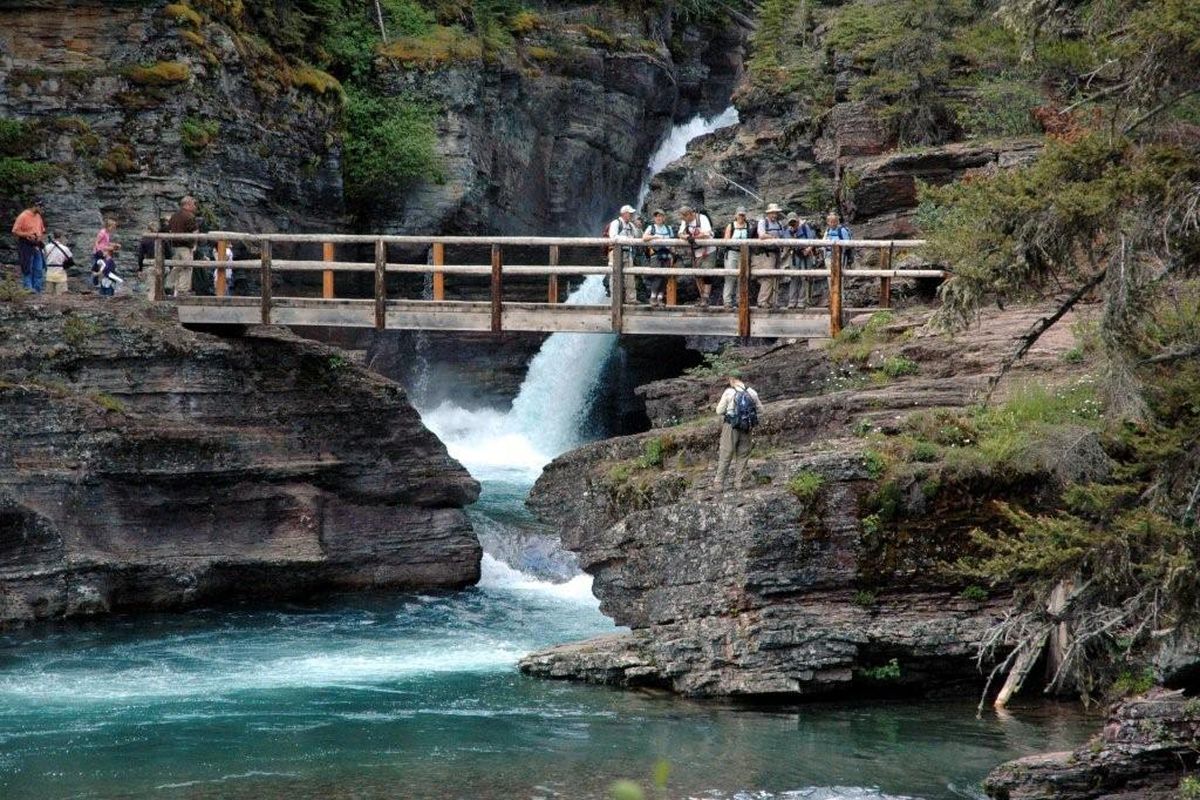Lacking drive
Shuttle service makes Glacier National Park’s breathtaking views accessible to hikers without cars
The shuttle bus allows visitors to be dropped off at numerous trails in the park. St. Mary Falls is a level, two-mile hike from a bus stop. (Mike Brodwater / The Spokesman-Review)
Glacier National Park has a new way to get around the park, including traveling Going-to-the-Sun Road, and it’s free. Park the car and see the park.
Three years ago was the opening of a new transit system made up of shuttle buses, with stops at hotels and trailheads. The project was successful, with 105,000 visitors taking advantage of the new convenience last year. A new transit center was built just within the park boundary in Apgar Village near West Glacier. This provides travelers from the Inland Northwest another means of escaping to a nearby, less-expensive vacation.
Usually, visitors to national parks have to be practically pried out of their cars to use public transportation. Mass transit is seen as a violation of our national park psyche of independence and self-reliance in the open, wild spaces, using our own vehicles. But for several reasons visitors’ resistance has been won over in Glacier.
First and foremost, the price of gas has encouraged people to use the free service. Most visitors travel up the spectacular Sun Highway to the Logan Pass Visitor Center, possibly taking a hike, and then return back to McDonald Valley. The entire day, up to 100 miles, can be gas-free using the shuttle.
The Park Service has its reasons for encouraging shuttle use. Going-to-the-Sun continues to get more and more traffic. Also, for the next several years renovation and repairs on the road will increase traffic jams. A shuttle service decreases the car impact. Nationally, the Park Service is working on decreasing carbon emissions in our national parks. Mass transit is already being used in Acadia, Zion and Yosemite national parks.
The shuttle extends down the east side of Logan Pass to St. Mary. However, a transfer must be made at the visitor center on the pass. There is not much of a wait because buses leave every 15 minutes during the busy time of the day.
Glacier National Park makes day hiking very attractive. The park offers (you have to ask for it) a day-hike guide with 63 hikes. Some of the walks are three-tenths of a mile, easy, and handicapped-accessible. Others are challenging, six- or seven-mile hikes with 2,400-foot elevation gains. But there are many in the three- to five-mile range that can be completed in part of a day.
The shuttle bus service makes it possible to start at one trailhead and get picked up at another at the end of the day. For example, hikers can catch the bus at Apgar and take it to Logan Pass Visitor Center and hike the Highline Trail. It parallels Going-to-the-Sun Road along the steep-sided Garden Wall. In places the edge of the trail drops off hundreds of feet down to the road. A cable has been attached to the wall side of the trail that allows people to hang on if they feel the need. This trail is mostly downhill to Granite Park Chalet and a good place to eat a packed lunch. Then there is a very steep four-mile downgrade to the “loop” on the Sun Highway and another bus stop from which you can get back into the valley to Apgar.
This 11-mile hike is in the heart of the park and the scenery is stunning. Glacier-carved mountains and valleys, waterfalls, wildflowers, persistent snow, mountain sheep and goats are all featured on this trail as the hiker drops about 3,000 feet.
A second day hike is a shorter, less strenuous trail that leads to three waterfalls and a lake whose trailhead can be reached by the shuttle. This trail can be reached by going to Logan Pass and transferring to the bus that goes east toward the town of St. Mary. Getting off the bus at St. Mary Falls bus stop, a 1.2-mile level walk will go the falls and additional 0.6-mile hike with a rise in elevation will bring Virginia Falls in sight. Backtracking and taking all trails to the right along the lake shore will lead to Baring Falls, which is very near the Sun Point bus stop.
The shuttle can also take hikers to a less strenuous walk in McDonald Valley. The trailhead is at Avalanche Creek, which is another bus stop. The destination is Avalanche Lake, which is surrounded on three sides by steep, rocky cliffs with a waterfall on the far end of the lake. This two-mile hike has only a 500-foot elevation gain and is one of the most popular trails in the park. That means, in the summer months, you won’t have the lake and the scenery to yourself. But it is a day trip that gets visitors out of the car. Using the shuttle, parking is not a problem, but after 10 a.m. spots are almost nonexistent near the trailhead.
The bus service is not perfect. At the end of the day, when everyone is trying get back to West Glacier, the buses do fill up. Users may have to wait for the next bus. Relax and enjoy the surrounding scenery until the next shuttle bus comes by in 15 minutes. The park also offers free ranger-led hikes and evening programs. Days of activities can be planned at little or no expense except for food and lodging.
The buses that travel the narrow Sun Highway were custom-built with a narrow profile which allows them to maneuver on the challenging road. The drivers are trained and experienced, and after driving it several times a day all summer they are prepared for any road condition or hazard. Let them drive. After all, you are on vacation and they’ll take you for free.

